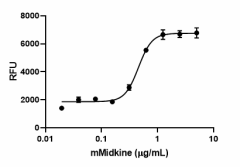- Regulatory Status
- RUO
- Other Names
- MK, MDK, Neurite Growth-Promoting Factor 2 (NEGF2), Retinoic acid-induced differentiation factor

-

Immobilized recombinant mouse Midkine supports the adhesion of C6 glioma cells in a dose-dependent manner with ED50 range of 0.2 - 0.8 µg/mL. Deep Blue Cell Viability™ Kit (Cat No 424701) was used to detect the adherent cells. -

Stability Testing for Recombinant Mouse Midkine. Recombinant mouse Midkine was aliquoted in PBS at 0.2 mg/mL. One aliquot was frozen and thawed four times (4x Freeze/Thaw), and compared to a control kept at 4⁰C (Control). The samples were tested in an adhesion assay with C6 glioma cells.
| Cat # | Size | Price | Quantity Check Availability | ||
|---|---|---|---|---|---|
| 792604 | 25 µg | $229.00 | |||
| 792606 | 100 µg | $675.00 | |||
Select size of product is eligible for a 40% discount! Promotion valid until December 31, 2024. Exclusions apply. To view full promotion terms and conditions or to contact your local BioLegend representative to receive a quote, visit our webpage.
Midkine was originally identified as a retinoic acid inducible gene in embryonic carcinoma cells. It is a heparin-binding neurotrophic factor expressed in various cell types during embryogenesis. Midkine promotes cell proliferation, differentiation, survival, and migration. It is involved in a variety of biological processes including neuronal development and angiogenesis. Midkine is also expressed in several carcinomas, suggesting a possible role in tumorigenesis. In addition, Midkine may play a key role in inflammation via the promotion of neutrophil and macrophage chemotaxis and suppression of regulatory T cell expansion. Midkine is a highly basic non-glycosylated protein with 121 amino acid residues that include ten conserved cysteine residues, which form five intra-chain disulfide bonds. There are several candidate receptors for Midkine including anaplastic lymphoma kinase (ALK), protein-tyrosine phosphatase zeta (PTPzeta), integrins, Notch2, and LRP1. Midkine is also known as neurite growth promoting factor 2 and has been shown to induce neuronal neurite outgrowth in vitro.
Product Details
- Source
- Mouse Midkine, amino acid (Val21-Asp140) (Accession: #P12025.2), with a N-terminal Met, was expressed in E.coli.
- Molecular Mass
- The 121 amino acid recombinant protein has a predicted molecular mass of approximately 13.38 kD. The DTT-reduced and non-reduced protein migrates at approximately 21 kD by SDS-PAGE. The predicted N-terminal amino acid is Val.
- Purity
- > 95%, as determined by Coomassie stained SDS-PAGE
- Formulation
- 0.22 µm filtered protein solution is in PBS
- Endotoxin Level
- Less than 0.1 EU per µg protein as determined by the LAL method
- Concentration
- 10 and 25 µg sizes are bottled at 200 µg/mL. 100 µg size and larger sizes are lot-specific and bottled at the concentration indicated on the vial. To obtain lot-specific concentration and expiration, please enter the lot number in our Certificate of Analysis online tool.
- Storage & Handling
- Unopened vial can be stored between 2°C and 8°C for up to 2 weeks, at -20°C for up to six months, or at -70°C or colder until the expiration date. For maximum results, quick spin vial prior to opening. The protein can be aliquoted and stored at -20°C or colder. Stock solutions can also be prepared at 50 - 100 µg/mL in appropriate sterile buffer, carrier protein such as 0.2 - 1% BSA or HSA can be added when preparing the stock solution. Aliquots can be stored between 2°C and 8°C for up to one week and stored at -20°C or colder for up to 3 months. Avoid repeated freeze/thaw cycles.
- Activity
- ED50 = 0.2 – 0.8 µg/mL as measured by the ability of immobilized protein to support the adhesion of C6 glioma cells. Deep Blue Cell Viability™ Kit (Cat. No. 424701) was used to detect the adherent cells.
- Application
-
Bioassay
- Application Notes
-
BioLegend carrier-free recombinant proteins provided in liquid format are shipped on blue-ice. Our comparison testing data indicates that when handled and stored as recommended, the liquid format has equal or better stability and shelf-life compared to commercially available lyophilized proteins after reconstitution. Our liquid proteins are validated in-house to maintain activity after shipping on blue ice and are backed by our 100% satisfaction guarantee. If you have any concerns, contact us at tech@biolegend.com.
Antigen Details
- Distribution
-
Expressed in various cell types during embryogenesis
- Function
- Neuronal adhesion, neuronal neurite outgrowth, intraperitoneal adhesion
- Ligand/Receptor
- Anaplastic lymphoma kinase (ALK), protein-tyrosine phosphatase zeta (PTPzeta), integrins, Notch2, and LRP1
- Bioactivity
- Measured by its ability to support adhesion of C6 glioma cells
- Cell Type
- Neural Stem Cells, Neurons
- Biology Area
- Cancer Biomarkers, Neurodegeneration, Neuroscience
- Molecular Family
- Neurotrophic Factors
- Antigen References
-
1. Muramatsu T. 1993. Int. J. Dev. Biol. 37:183.
2. Kaneda N, et al. 1996. J. Biochem. 6:1150-6.
3. Bohlen P and Kovesdi I. 1991. Prog. Growth Factor Res. 3:143.
4. Muramatsu H and Muramatsu T. 1991. Biochem. Biophys. Res. Commum. 2:652.
5. Reynolds PR, et al. 2004. J. Biol. Chem. 279:37124-32.
6. Inoh K, et al. 2004. Biochem. Biophys. Res. Commun. 317:108-113.
7. Weckbach LT, et al. 2011. Scientific World Journal 11:2491-2505.
8. Weckbach LT, et al. 2014. Blood 12:1887-96. - Gene ID
- 17242 View all products for this Gene ID
- UniProt
- View information about Midkine on UniProt.org
